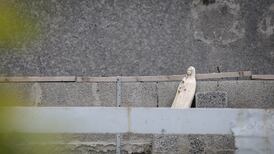Death, they say, is a great leveller. And the late Princess Diana succeeded, in the early hours of yesterday, in putting all of us on the level of the paparazzi.
For there we were - the foreign correspondents of Paris - staking out the tunnel of death beneath the Pont de l'Alma with all the intensity of the snappers originally blamed for the princess's death.
And why? Because the French police were producing - for our benefit, I suspect - the crumpled Mercedes S 280 in which the princess was fatally injured exactly a month ago. At 9.15 on Monday evening, a big, white, flat-bed truck with a crane dangling over its cargo inched backwards into the tunnel.
Police had shrouded the car in a green tarpaulin. Lit up by spotlights and more than a dozen television cameras, the relic was a sinister mockery of Diana's coffin, draped with a royal standard on a gun carriage.
But the green tarpaulin looked vaguely military, and the Mercedes massive; perhaps a tank on a transport carrier was a more apt description. Journalists struggled to see from the stretch of pavement where we were corralled behind four sets of metal railings.
The shape under the green tarpaulin was disturbingly deformed. It jack-knifed and bulged on one side. In a five-hour stake-out - much longer for some - this was all we would see of Diana's Mercedes.
A US television network tried to rent space in a building overlooking the entrance to the tunnel, only to find that Paris Match had beaten them to it. Match photographers paid 15,000 francs (£1,700) for the spot, and they weren't going to share it.
A French police reporter told me how he was enticed down to the Pont de l'Alma by a gendarmerie source. "He called me this morning and whispered, very under-the-coat-like: `Keep this to yourself. I can't say too much, but if you could be at the Pont de l'Alma around 7.30 this evening'. . ."
When the reporter arrived on the scene, he found more than 100 journalists from France, Britain, the US, Japan, Italy, and Norway already waiting. "This is supposed to be a secret inquest, but we were all tipped off - to see nothing. I think it was done deliberately, to show that a month after the accident, the police are working on it."
A police technician stood on the high ground at the mouth of the tunnel, behind a surveyor's instrument on a tripod. The investigating magistrate, Judge Herve Stephan, we speculated, was trying to determine the speed of the Mercedes at the time of the crash, its trajectory, what witnesses could or could not see. We heard the police were using laser instruments, but no one could source this information.
A man in a sports jacket crossed the divide between the police cordon and the press, to be mobbed by cameramen. A badge with a tricolour identified him as a press officer for the prefect of Paris.
"I have nothing to say to you," he announced. "I know nothing. The car is there. There are lots of authorities down there. It may last one hour, or two hours or three." A wire agency reporter groaned with frustration. "We have to stop this Diana mania," he complained. "This is not the fall of the Berlin Wall. This is a non-event." But he, like the rest of us, would be there until 1.30 in the morning.
A wild rumour started that the police were going to drive a new Mercedes into the tunnel at high speed just after midnight. When a reporter announced solemnly: "It's 12:20 - the time of the accident," an almost imperceptible drawing in of breath ran through the crowd of journalists. Beyond the Pont de l'Alma, the lights on the Eiffel Tower went out. At 1.30 a.m., there were still photographers perched on rubbish bins and parking meters.
Judge Stephan had fooled us all: he and the Mercedes had exited through the other end of the tunnel at 1.20. But we'll have another chance. The exercise was only a "pre-re-enactment", just one instalment in the saga of Princess Diana's revenge on the press.
The death of Princess Diana generated more newspaper coverage in Britain than even the most dramatic events of the second World War and set a media record, according to Durrants Press Cuttings, which monitors nearly 200,000 newspapers and magazines a year.







